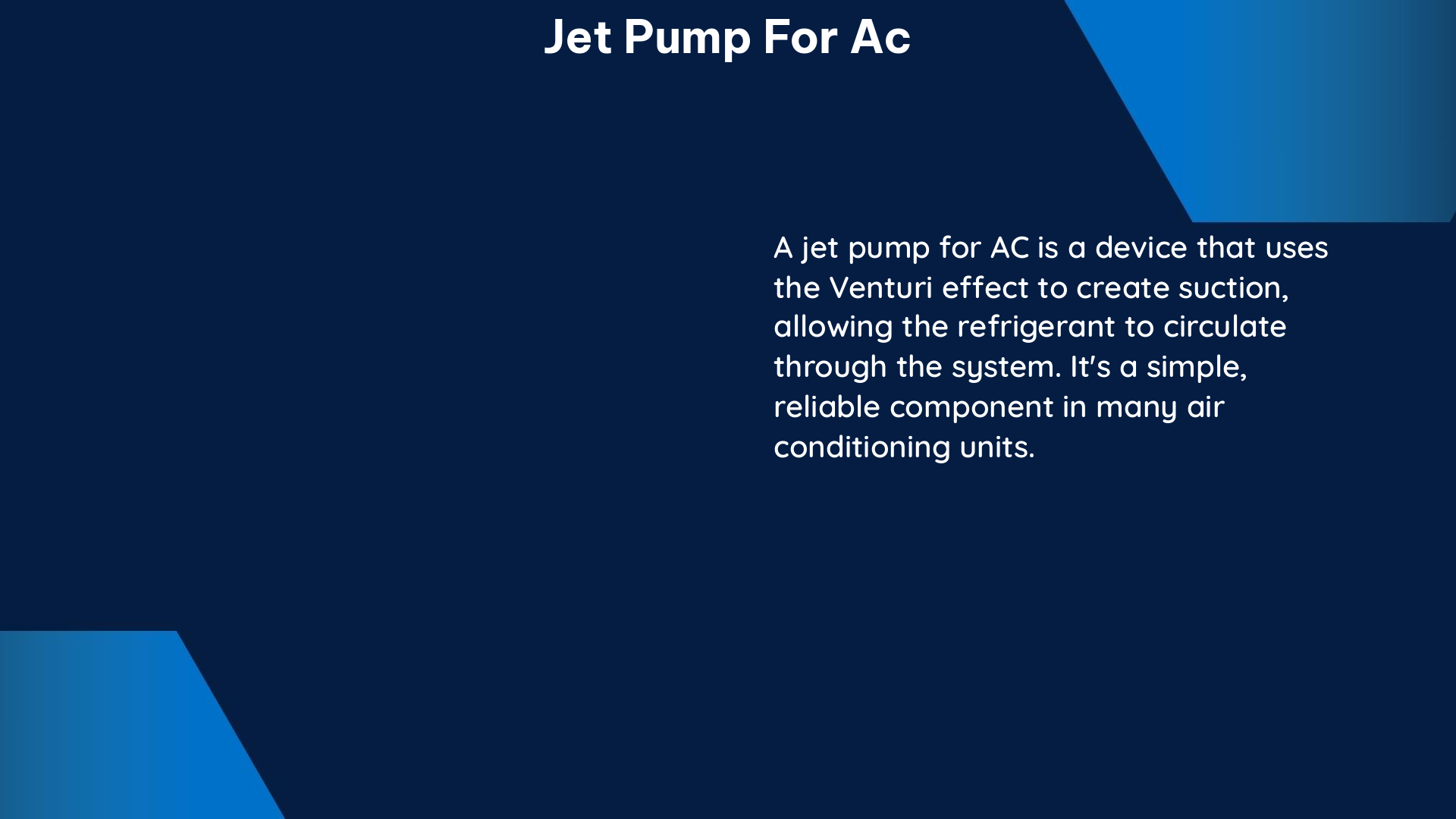Jet pumps are an integral component of air conditioning (AC) systems, responsible for efficiently transferring heat from the indoor unit to the outdoor unit. These pumps play a crucial role in ensuring the optimal performance and energy efficiency of your AC system. In this comprehensive guide, we will delve into the technical details of jet pumps for AC, exploring their working principles, efficiency metrics, and the latest advancements in the field.
Understanding Jet Pumps for AC
Jet pumps, also known as ejector pumps, are a type of fluid-driven pump that utilize the Venturi effect to create suction and transfer fluids. In the context of AC systems, jet pumps are used to circulate the refrigerant between the indoor and outdoor units, facilitating the heat transfer process.
The key components of a jet pump for AC include:
- Nozzle: The nozzle is responsible for accelerating the high-pressure refrigerant, creating a high-velocity jet.
- Suction chamber: The suction chamber is where the low-pressure refrigerant from the indoor unit is drawn in.
- Diffuser: The diffuser is a diverging section that slows down the high-velocity jet, converting the kinetic energy into pressure energy.
The interaction between these components creates a suction force that pulls the low-pressure refrigerant from the indoor unit, effectively transferring heat from the indoor environment to the outdoor unit.
Efficiency Metrics for Jet Pumps

The efficiency of jet pumps for AC systems is typically measured in terms of their Coefficient of Performance (COP), which is the ratio of the heat energy transferred to the electrical energy consumed. A higher COP indicates a more efficient jet pump.
According to the report “Heat Pump and Air Conditioner Efficiency Ratings: Why Metrics Matter,” the built-in firmware of variable-speed Cooling and Heating Air Conditioners (CAC/HPs) can have a significant impact on real-world performance. The report suggests that a load-based testing procedure, which fully characterizes heat pump performance under realistic operating conditions, including the systems’ built-in firmware, would be a much better rating metric than the current fixed compressor speed test procedures.
Repeatability and Reproducibility of Jet Pump Efficiency Testing
A study conducted by the Federal Institute for Materials Research and Testing (BAM) in Germany examined the repeatability and reproducibility of jet pump efficiency testing. The study involved round-robin testing of CAC/HP units using the fixed compressor speed test procedure at seven different test labs.
The results showed that the standard deviation of reproducibility for the EN 14825 standard was 7.8%, with a maximum deviation of 24% in Seasonal COP values. However, BAM claimed that their test method, which accounts for the on-board control algorithms of the units under test, is both repeatable and reproducible, with a degree of repeatability comparable to the current fixed compressor speed standard.
Advancements in Jet Pump Efficiency Measurement
The CSA EXP07 method is a more advanced approach to measuring the efficiency of jet pumps for AC systems. This method takes into account the on-board control algorithms of the units under test, providing a more accurate representation of their real-world performance.
A comparison of the relationship between Heating Seasonal Performance Factor (HSPF) and heating Seasonal Coefficient of Performance (SCOP), or Seasonal Energy Efficiency Ratio (SEER) and cooling SCOP, was not conducted due to the fact that these are two different metrics based on different measurement conditions and methodologies. However, comparing different models with similar SEER and HSPF ratings to the results using the CSA EXP07 method showed that the relative efficiencies of those models were significantly different.
DOE CCHP Tech Challenge Specifications
The U.S. Department of Energy (DOE) has established the CCHP Tech Challenge, which sets specifications for variable-speed Cooling and Heating Air Conditioners (CCHPs) to pass. One of the requirements is that the minimum capacity at 47°F, validated using the “Min/Mild” load-based test, shall be at least 30% less than the nominal capacity at 47°F (i.e., capacity for test H1N of appendix M1).
This requirement ensures that variable-speed CCHPs can maintain efficient operation even under milder ambient conditions, further enhancing the overall energy efficiency of the AC system.
Conclusion
Jet pumps play a crucial role in the efficient operation of AC systems, facilitating the transfer of heat from the indoor to the outdoor unit. By understanding the technical details of jet pumps, including their working principles, efficiency metrics, and the latest advancements in measurement techniques, you can ensure that your AC system is operating at its optimal performance level.
Remember, the efficiency of jet pumps can be significantly impacted by the built-in firmware and control algorithms of the AC system. Therefore, it is essential to consider load-based testing procedures and advanced measurement methods, such as the CSA EXP07 method, to accurately assess the real-world performance of your AC system.
By staying informed about the latest developments in jet pump technology and efficiency measurement, you can make informed decisions when it comes to maintaining, upgrading, or replacing your AC system, ensuring long-term energy savings and a comfortable indoor environment.
References:
– The Hull Truth – Question about water pump AC
– IRS Notice 2023-44 – Heat Pump and Air Conditioner Efficiency Ratings: Why Metrics Matter
– DOE – CAC/HP Test Procedure Rulemaking
– DoItYourself.com – Question about water pump AC
– NERC – Dynamic Load Modeling Tech Ref

The lambdageeks.com Core SME Team is a group of experienced subject matter experts from diverse scientific and technical fields including Physics, Chemistry, Technology,Electronics & Electrical Engineering, Automotive, Mechanical Engineering. Our team collaborates to create high-quality, well-researched articles on a wide range of science and technology topics for the lambdageeks.com website.
All Our Senior SME are having more than 7 Years of experience in the respective fields . They are either Working Industry Professionals or assocaited With different Universities. Refer Our Authors Page to get to know About our Core SMEs.